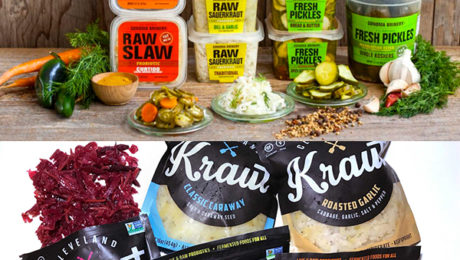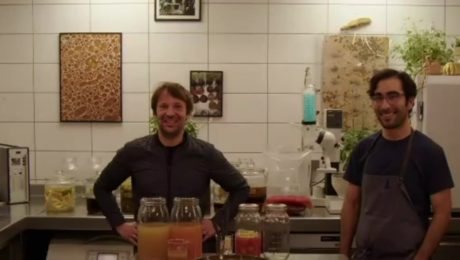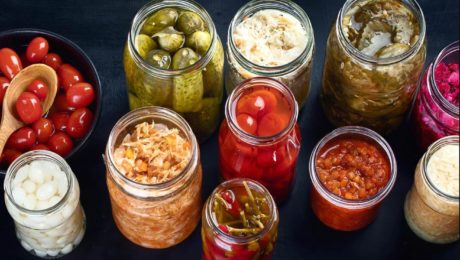Cleveland Kitchen Acquires Sonoma Brinery
One of the under-the-radar stories from the recent Expo West was another acquisition in the fermented foods space, coming on the heels of the Bubbies and Wildbrine purchases. Ohio’s Cleveland Kitchen, producers of sauerkraut, kimchi, salad dressings and pickles, bought Healdsburg,Calif.-based Sonoma Brinery (makers with a similar line-up of pickles, kraut and pickled vegetables). No public announcement has been made, but executives from both companies confirmed the transaction to TFA. Sonoma Brinery founder/owner David Ehreth is expected to remain with the company. [Note – both Ehreth and Cleveland Kitchen’s Drew Anderson have been TFA Advisory Board members since the organization’s inception.]
- Published in Business
Fermentation Takes Center Stage in the Coffee Industry
Coffee production is an enormous, global industry, but the fermentation of coffee beans has not been a major focus for producers — until now. Highlighting the scope of the industry and this new emphasis on the impact of fermentation, The Fermentation Association’s webinar El Estado Del Arte En La Fermentación Del Café generated registrations from around the world. Registrations were nearly twice what TFA’s largest webinar generated.
TFA’s first Spanish-language webinar, the final count of registrants was well over 1,000, and came from 42 countries. The continents of North and South America, Europe, Africa, Asia and Australia were all represented. Registrations from key coffee-growing areas — Colombia, Mexico, Peru and Honduras — accounted for 70% of those that signed up. But we had folks from Ethiopia, Belgium, Nepal, Laos and the United Arab Emirates as well!
TFA partnered with the Specialty Coffee Association (SCA) last year and produced a webinar in August entitled The State of the Art in Coffee Fermentation. SCA’s Technical Officer, Dr. Mario Fernandez, brought together two esteemed speakers in the industry that discussed different approaches to fermentation. Felipe Ospina, CEO of Colors of Nature Group, and Ruben Sorto, CEO of BioFortune Group, represented two sides of the subject. At the risk of oversimplifying, Ospina favors traditional, natural fermentation methods. Sorto is investing in how to apply the technologies and processes from other food and beverage production industries — like winemaking, for example — to enhance the end product. Ospina connected from offices in Japan; Sorto spoke from his Honduras operations.
These speakers also were part of last year’s English-language webinar on the same subject and with the same speakers. The response to that session was so overwhelmingly positive that it led us to reprise the session, but to do it this time in Spanish. It was a bit challenging for our non-Spanish-speaking TFA team, but we were helped out enormously by our colleague from Monterrey, Mexico, Raquel Guajardo, a fermentation author, educator and entrepreneur. Dr. Fernandez, after being instrumental in planning and promoting both sessions, was called away suddenly on the day of this webinar. Ms Guajardo filled in admirably as our last-minute replacement moderator.
We look forward to more collaborations with SCA. Watch for another joint effort in late April/early May, after SCA’s Specialty Coffee Expo in Boston, April 8-10.
- Published in Business, Food & Flavor
Redzepi: “Fermenting is our future”
An interesting indication of how quickly and decisively fermentation is moving into the U.S. food mainstream is a recent online event organized and offered by American Express and restaurant booking service Resy, “A Fermentation Workshop with Noma.” For $50, one could sign up for an hour-long Zoom — introductions from Noma’s René Redzepi and Jason White, and demonstrations of making lacto-fermented tomatoes and a juice-based kombucha, all moderated by renowned food writer Ruth Reichl — and a copy of 2018’s “The Noma Guide to Fermentation.” The event sold out in minutes.
Redzepi (Noma chef and co-owner) and White (Noma’s head of fermentation) were in their fermentation lab at the restaurant, and gave concise, compelling comments on the long history of fermentation and its importance. They noted the healthful aspects of the process but emphasized its ability to produce delicious flavors.
“One of the most important things for me as a fermenter is definitely having a closer look at nature, and also being able to create new and interesting flavors that can have beneficial effects on humans, meaning it can make us healthier, it can make our dinners more exciting and also we can teach future generations how they can interact with nature as well,” White says. “The power of fermentation is a really good bridge to that because, in one way or another, in every culture, in every place on earth, there are people who have been doing it for thousands of years. I think it’s important for us to carry the torch. And I think carrying the torch of fermentation is definitely my biggest dream, to carry it for another thousand years.”
When Noma opened over 18 years ago, it was in the dead of winter and they struggled to deliver meals made from Nordic ingredients. “We were really desperate to find food,” Redzepi continues. By spring, they began foraging, “it grounded us and gave us direction.” A few years into foraging, they wondered how they could take the abundance of spring and summer ingredients and use it in the long winter season.
“That’s when we started dabbling into fermentation,” he says. “And from that moment on, a whole new world opened up for restaurant Noma. You could even say fermentation eclipsed foraging because we found out, through the yeast and the mold and the bacterias, we could simply create such new flavors that would transform our kitchens forever. We started tapping into the community worldwide of fermenters and traditional fermentations, adapting them to our ingredients and our region and thus creating a new set of tools that has really engrained itself into every single Noma dish. You don’t eat anything at Noma that doesn’t have ferments in them.”
“Instead of food waste, you can ferment it into something delicious,” he adds.
They made the recipes seem easy to execute (though I suspect the presentation of SCOBY might have put off some participants). And, to ensure at least a small dose of titillation, they proffered a container of one current project in the lab, “Reindeer Penis Garum.” They used this as an example of how fermentation can minimize waste by finding applications for what would otherwise be scrap or trash.
The detailed discussion of kombucha was illuminating, including an interesting contrast with vinegars. Noma makes numerous kombuchas, both for direct consumption and for use as an ingredient. Redzepi expressed his personal perspective, which helps explain why. He says he has yet to find a commercial product “that’s worth buying” — and it’s easy to make yourself.
It was great to see fermentation as a front-and-center topic, but there is still work to be done. The literature that was sent to all participants to accompany the presentation included references in the kombucha recipe to “backstop” and “backdrop” liquid — though they meant “backslop.”
- Published in Business, Food & Flavor
Highlights from TFA’s Member Survey
The Fermentation Association recently surveyed our community to better understand who has engaged with us, how their businesses are doing and to gauge the impact of the pandemic. We want to share the very interesting results.
A few qualifying comments first, however. This survey should not be interpreted as producing a profile of the fermented industry — it reached only those with whom we have connected since TFA was launched in 2017. This group is heavily weighted to Food and Beverage Producers and those in the Science, Health and Research fields. And, even as we note surprisingly high response rates below, the quantities of responses to certain questions were small and would not meet standard analytical thresholds of statistical significance. So please treat the comments and conclusions that follow as directional rather than definitive.
We received 450 full or partial responses — nearly twice the number we had expected and what we would have considered “good.” Not surprisingly, the bulk of these were from Food and Beverage Producers — just under half — with a strong representation of the Science, Health and Research community, a little less than one-fifth. The balance of the respondents were classified as Supplier or Service Provider (9%); Chef/Writer/Educator (8%); Retailer/Distributor/Broker (3%); Food Service/Hospitality (3%); or fell into a miscellaneous Other category (12%).
We will be presenting further analyses and follow-up discussions in the coming weeks. This article focuses on the two largest segments: first, Food & Beverage Producers; then, Science, Health, and Research.
FOOD & BEVERAGE PRODUCERS
- We found that over 80% of our Producers are small businesses with 25 or fewer employees, and 65% had 2020 sales of less than $500,000. That said, over 11% of the companies represented are toward the other end of the spectrum, with 100 or more on staff, and 13% with revenue of over $10 million.
- We reach a lot of Owners/Founders/Senior Executives, over 70% of respondents. The next most well-represented functional areas are Operations and Product Development.
- These businesses are spread across the developmental timeline — a little over 40% are selling at the local level, or earlier in their growth cycle (selling at farmers market or still in testing/pre-launch mode). Yet 45% are selling regionally, nationally or internationally.
- Retail is still the largest (45%) channel of sale for these producers, but Direct-to-Consumer (DTC) is just slightly behind at 40%, with the remaining 15% through Food Service/Hospitality.
- Sauerkraut/Kimchi, Pickles, Condiments/Sauces and Kombucha were the most frequently-listed product categories, each mentioned by more than 20% of the producers. Kefir, Vinegar/Shrubs, Wine and Miso also were mentioned often. Of the 25 product categories listed, we had respondents involved in every one — except poor, slimy, and unrepresented natto.
- Nearly half of producers selling at retail and/or DTC had sales gains in 2020 and another third maintained their revenues. Not surprisingly, nearly 40% of producers selling into food service saw sales take a hit — only 15% reported gains.
- The Covid-19 pandemic caused a host of issues for producers, though their prevalence seemed to vary depending on the size of the company. Among larger producers, over 90% had issues meeting demand, with the primary problems being shortages of raw materials, packaging and staff, as well as distribution delays. Fewer of the small producers reported issues, but their problems fell into the same categories. Financial difficulties were cited more often among small producers.
- Nearly 30% of producers took advantage of the government’s Payroll Protection Plan.
- This year appears to continue or build on the sales levels achieved in 2020 for most producers. Nearly 40% report first quarter 2021 sales at the same level as last year, and nearly 50% reported further increases. And producers are optimistic about continuing these trends, with a mere 5% anticipating sales declines.
- Most (nearly two-thirds) of responding producers did not participate in tradeshows and conferences, and therefore felt no business impact from show cancellations in 2020.
- The producers that did participate in events favored the Natural Products Expos, Fancy Food Shows and IFT Show. While some felt that they lost short-terms sales and their future growth was hurt by the shows being cancelled, nearly 30% noted that they saved money and time by not attending. Some of those savings were reinvested in increased marketing, DTC sales and virtual events.
- Interestingly, half of the producers plan to continue their involvement as events resume at the same level as before the pandemic, and fully one-third plan to increase activity.
- Looking ahead, producers see numerous challenges on the horizon, led by a need for expanded distribution. They expect many of the recent shortages to continue to challenge, compounded by production, facility and financial constraints. While Covid protocols and food safety concerns persist, they are joined by the need for product development, e-commerce skills, and consumer marketing
- The clearly-articulated top priority for producers is a better-educated consumer. When asked what would foster increased consumption of fermented foods and beverages, the top item for nearly 70% is consumer education as to the nature and benefits of fermentation. The next highest priorities all support this same goal — more research into health impact (+40%), greater familiarity with flavors of fermentation (+40%) and more exposure at retail (+30%).
SCIENCE, HEALTH & RESEARCH
- The bulk — nearly 75% — of these respondents work in an academic environment, with very small clusters in government and medical/health organizations. It’s a well-educated group, with over half holding doctorates, plus another quarter with Master’s degrees. Roles are split quite evenly into thirds — professors, science/technical support and students/postdocs.
- Over 60% of these respondents are looking into connections between fermentation and health; roughly half are specifically focused on gut health and the human microbiome. Overall, three-quarters are currently researching fermentation and fermented products. Their activities, though, span the full spectrum of product categories. All the key categories among our producers — Sauerkraut/Kimchi, Pickles, Condiments/Sauces, Kombucha and Kefir — were well-represented in research. But they were joined by meaningful work across the board — Yogurt, Beer, Cheese, Alternative Proteins, Koji, Wine, Sourdough, Tempeh, Tea — even Natto!
- Slightly more than a third of this group is involved with fermented alternative proteins – an important, emerging category.
- Funding for research showed more declines (30% of respondents) than gains (under 15%) over the last year. But half of our sample expects funding to increase in the coming 12-18 month.
- Our Science, Health & Research respondents were split in how they viewed the interest in fermentation research — 60% felt the focus was increasing, but the topic was not yet a top priority. Yet a third saw fermentation as a hot topic, with more emphasis and activity than ever.
- Respondents in this group shared the views of producers that the key activities that would drive increased consumption of fermented products are:
- Consumer education about fermentation
- More research into health benefits
- Greater consumer familiarity with fermented flavors
- Published in Business, Food & Flavor, Health, Science




